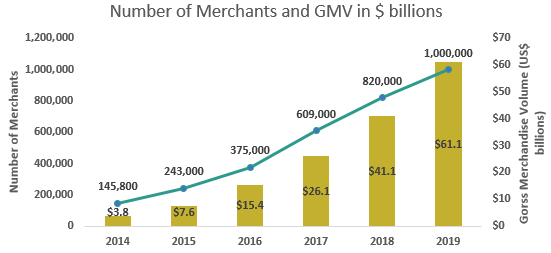85 per cent - the increase in Shopify’s stock price this year as at June 5, making it the best performing stock on the TSX year to date. The origins of the company’s name are: to shop and to simplify. Shopify’s increasing e-commerce dominance is fueled by its ability to provide small and medium sized businesses worldwide with a user-friendly and cost-effective e-commerce platform. In this first part of our Shopify series, we provide an overview of Shopify and its success in becoming one of the largest e-commerce platforms in the world.
E-commerce Solution
Ottawa based Shopify offers an avenue to build an e-commerce presence through a simple, four step process:
In the past, laying down the foundations of an e-commerce store was not easy for business owners. With Shopify, merchants can offer their products and services online at an affordable cost. The chart below demonstrates the rapid adaptation of Shopify as businesses seek to increase their e-commerce presence.
Shopify’s History
Shopify was initially a solution to a problem the founders experienced. Before being a platform to build e-commerce stores, the original Shopify was a store itself known as Snowdevil. It was founded in 2004 to sell third party snowboards online. After getting increasingly frustrated at the lack of available software in the early 2000s to launch their e-commerce snowboard shop, the founders took matters into their own hands and launched Snowdevil via a Shopify barebone platform.
The initial response to Shopify itself was far more overwhelming than for the Snowdevil e-commerce store. The founders decided to shelf Snowdevil and focus on assisting other merchants pursuing e-commerce instead. Shopify was officially launched in 2006.
Since then, Shopify has grown rapidly. We highlight several key milestones along the way in the timeline below:
Business Model
Shopify generates revenue in two ways:
A. Subscription model
Customers can choose between three subscription plans: Basic Shopify, Shopify and Advanced Shopify.
Shopify also offers Shopify Plus, a subscription plan tailored to larger businesses with higher volume sales. Think of Shopify Plus as the enterprise grade solution for e-commerce. The pricing of Shopify Plus varies by customer.
B. Merchant Solutions
In addition to varying features, each subscription plan charges varying payment processing fees. These consist of transaction fees, referral fees, credit card rates and point of sale (POS) fees. As seen below, Shopify’s merchant solutions revenue has seen an uptick along with the increase in sales processed.
Shopify has successfully built a sustainable Software as a Service (SaaS) business model on subscription fees and revenue growth based on customer transaction volume.
Customers
Over the years, Shopify has successfully increased its customer base exponentially. Its current customer base consists of a diverse set of companies and brands, including:
Other notable Shopify customers include Budweiser, Sephora, Tesla, Nestle’s Nescafe, Red Bull, MVMT, World Wildlife Fund Canada, Los Angeles Lakers Store, Manitobah Mukluks, Kylie Cosmetics… The list goes on and on.
““The whole reason to go to Shopify Plus was to best serve our customers. It wasn’t about reaching a certain turnover; it was about providing a seamless experience. We wanted custom checkout, we wanted automation tools, and with the Plus platform you have that out of the box.””
Anticipating Customer Needs
Shopify’s competitive advantage is its ability to anticipate what customers want and respond swiftly, which has enabled the company to distinguish itself from its competitors. Management understands the importance of being proactive to address customer needs for business sustainability and growth.
““We view Shopify Plus as a partnership. We felt the relationship was the strongest it would be out of any player that we could have chosen. We understood that the platform is continually going to get better. At the end of the day, performance and everything aside, we feel like we’re in this together.””
In 2020 alone, Shopify introduced additional features and services to make it even more convenient for its merchants. Some of the offerings are highlighted below:
A. For Shopify merchants
Shopify Balance: Business accounts, similar to what traditional banks offer but with no monthly fees and no minimum balances.
Shopify Card: Physical and virtual cards for merchants to buy inventory, track spending or conduct ATM withdrawals.
Shopify Capital: Offering cash advances between $200k and $500k in Canada and US$200k and US$1M in the US; $1B allocated to date.
Collect tips: Merchants can collect tips from consumers online.
Shopify POS: Offering merchants contactless payment hardware in physical retail locations post-COVID.
B. For customers of Shopify merchants
Buy now, pay later option: Allows consumers to pay for products purchased in installments.
Shopify POS: Customers have access to what merchants have available in-store via the website.
Local pickup: Enable merchants to offer customers curbside pickup services.
Gift cards: Allows merchants to sell gift cards to their own e-commerce stores.
Business owners appreciate the company taking the initiative to introduce industry leading services to their e-commerce stores. They also witness the impact of these offerings to the continued growth of their businesses over time. This has enabled Shopify to build an entire e-commerce ecosystem that its loyal customer base increasingly relies on.
““Shopify tries to be the best possible piece of software that you could add to your business, if you are a retail business. Trying to solve, ideally, every problem that you might encounter along the way, that can be solved in digital means, in such a way that you can focus completely on your relationship with your customers and your products, and be successful this way. “”
Shopify’s success stems from its focus on customer satisfaction. The company strives to offer a convenient, user-friendly solution to business owners at a reasonable cost. Its pursuit of customer satisfaction is further evident in its continued efforts to anticipate future customer needs.
In the next part of our Shopify series, we investigate Shopify’s surge to the top of the Toronto Stock Exchange. We compare Shopify to the top Canadian companies as well as its competitors within the e-commerce space. We aim to provide insight on its current valuation and how sustainable this is going forward.
Check out part two here.
Did you know? Whitehorn are experts in acquisition mandates. The Whitehorn team has decades of experience assisting and advising Western Canadian companies in acquisitions to accomplish their goals.
Contact us today to find out more!













